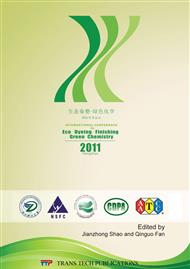p.235
p.239
p.244
p.249
p.255
p.261
p.266
p.271
p.275
The Durability of Flame Retardant and Thermal Protective Cotton Fabrics during Domestic Laundering
Abstract:
Flame retardant fabrics have been broadly used for protective clothing, which have strictly requirements on both flame retardancy and thermal protection. Usually, domestic laundering will be carried out frequently to clean these protective garments. However, little research on the performance durability of this type of fabrics after domestic laundering has been reported. This paper selected fabrics of 8 types of cotton and its blend fibers, which were treated with flame retardants Pyrovatex CP, Proban, CFR-201, SCJ-968 respectively. The damaged length, after flame time, after glow time, TPP value, thermal resistance value, weight, thickness, air permeability and water vapor permeability (WVP) of the samples were measured before and after 15 cycles domestic laundering cycles. Results show that the flame retardancy of the 8 fabrics reduce with launderings as measured by the increase in damaged length and after glow time. The TPP increase probably resulted from the increase in the thickness and thermal resistance of the finished fabrics. Domestic laundering resulted in only a slight change in the comfort properties of the fabrics.
Info:
Periodical:
Pages:
255-260
Citation:
Online since:
January 2012
Authors:
Price:
Сopyright:
© 2012 Trans Tech Publications Ltd. All Rights Reserved
Share:
Citation:


